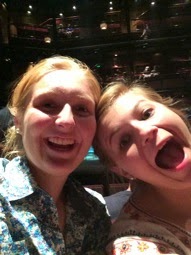One,
two, three. Smile for the selfie! We live in a world that emphasizes self-image.
Whether for public or personal reasons,
people care about how others see them. In
the production of Henry IV Part 1,
two important characters render different strategies for designing
self-image. King Henry IV (Jasper
Britton) hides in life to preserve it; Sir John Falstaff (Antony Sher) parades
through life to build it. Because we
live in a “selfie-driven” society, Henry
IV Part 1 prompts us to think about our own self-image: how others view us
and why we make the choices that we do.
King Henry
thinks that self-image needs to be controlled.
After obtaining the crown dishonestly, he has good reason to take care
of his personal image and reputation. The
king carries himself with caution, safely guarding his secrets from people. Even his persona onstage conveys this:
handling the crown with shaky hands, shouting at people, making a show of his
religion, pondering a corrupt past, and fearing an uncertain future. King Henry has to play all of the right cards
to keep from losing the throne. Since his
plan is to make public appearances sparingly, he carefully controls what the
people see, know, and hear. The king
believes this is the key to success, and his self-image is defined by a single
rule: secrecy.
Falstaff,
on the other hand, believes that self-image should be flaunted. He is proud of his less than respectable
decisions and enjoys living life as a fat drunk. Falstaff holds back nothing as the laughing
stock of the entire play, pretending to be completely carefree. However, he has an agenda just like the
king. While King Henry hides his secrets
to keep the crown, Falstaff lives brashly on purpose to be remembered. He cannot be forgotten; he cannot be left in
the dust. Falstaff strives to make the
right connections to build up his name, and friendship with Prince Hal (Alex
Hassell) is his ticket to a better life.
In fact, there is a tavern scene where Hal and Falstaff tease each other
and participate in role-play. Through
his words and actions onstage, we see Falstaff really try to persuade Hal to
remain his friend. Self-image is
Falstaff’s tactic for manipulating his way up the ladder.
In this
production, staging also contributes to our understanding of King Henry’s and
Falstaff’s views on self-image. King
Henry wants to hide his secrets, so the set lights intentionally dim during
some of his scenes. The king is a
secretive leader who acts quietly and hides in the shadows. On the other hand, scenes involving Falstaff
are usually bright and very loud. Many
of his main scenes take place in the tavern where he constantly makes a fool of
himself. Falstaff is the physical center
of attention, rarely standing on the edge of the stage. In fact, chairs, lights, and people are
usually directed towards him. These deliberate
stage plans contribute to our impressions about their two opposing perspectives.
King
Henry and Falstaff spend a lot of energy focusing on self-image like some continue
to do our current world. While there is
much that affects self-image, a few pieces distinctive. Social media profiles carry great weight. People can spend hours trying to present the
perfect Internet image for work, school, dating, family, or friends, regardless
of whether it is actually true.
Similarly, the public image King Henry stages in the play is not totally
honest. Another significant piece of
self-image is the people we spend time with.
While people are often different from their friends, peers still affect
each other. Falstaff, though not a
common person, spends time drinking with people in taverns. Although they are not on the same level, the
tavern people still contribute to Falstaff’s reputation. Peers are very strong influences. Finally, personal decisions are an important
part of self-image because choices often tell of character. If a boy chooses to help an elderly person
across the street, he is seen as kind.
If a woman tells the truth in a hard situation, she is seen as honest. If a soldier places his life on the line for
others, he is seen as selfless. King
Henry’s and Falstaff’s choices defined their characters; our decisions define
us.
Through
characters in Henry IV Part I, we are
encouraged to develop our own ideas about self-image. King Henry’s perspective is very different
from that of Falstaff, and our perspectives are likely different from both of
theirs. In my opinion, we should spend
some time addressing this to help us figure out who we want to be and who we
want to become. However, I do not
believe that it should consume our lives, like it did for King Henry and Falstaff. Life is about so much more than creating a
perfect image. Young Prince Hal is
influenced by these two men, but he eventually chooses his own path and becomes
a man of honor who fights battles with dignity.
This personal decision makes Hal a more mature character. Likewise, it is up to us to decide what we personally
believe. We have to form our own
opinions about self-image in our world full of selfies.


No comments:
Post a Comment